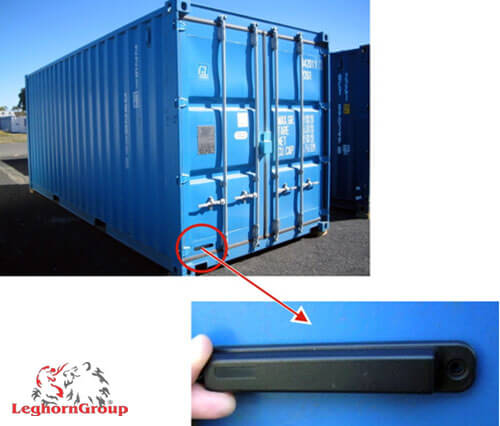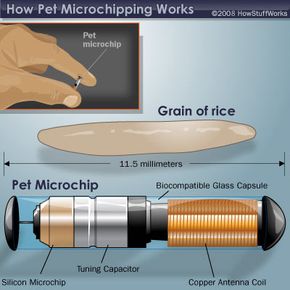A really good point here that’s quite amusing is that most of these dunderheads who are so terrified of the COVID vaccine “tracking” them that they’re willing to risk dying of COVID are probably avid users of credit cards, loyalty cards, and other sorts of “rewards” cards, all of which build fantastic databases of everywhere that person goes to buy anything, the location, the thing they bought, what they paid for it, etc. Pretty much their whole lifestyle exists on commercial databases. That data is then aggregated and sold to third-party marketers, which is why data mining is such a hot business these days. But before it’s aggregated it exists in the original database with all their personal travel and shopping habits, traceable directly back to them. The amount of personal data these idiots are intentionally exposing is just amazing. But hey, it doesn’t involve an injection, and it doesn’t involve the Evil Gubbermint, so it must be OK, right?
Where do they find these microchipped syringes? I’ve worked in healthcare for a little more than 20 years, syringes are bought in bulk. The only scanning I’ve ever seen like this is not the syringe but the medication. In some facilities they do scan the medication and the pt ID band to make sure they match. I’ve seen this with by mouth meds, but I suppose they might do it with injectibles, but the thing being scanned is a label, not the syringe. The label is created at the pyxis. If there is something else, I’ve never seen it or heard of it.
To ensure even the most clever, freedom loving Americans end up on the government’s database, the chip is designed to replicate itself and the copies then embed themselves in saliva droplets.
So fight the government: wear a face mask and socially distance.
I prefer the version where they cut the needle in half, carved grooves in it, and then screwed the pieces back together.
There need not be a rational technical explanation for what the chip does. It knocks your chakras out of line with your pranas. Its frequency disrupts your immune system. It turns your kids gay, and Communist, by serving as a focus for demonic intrusion. It lets the 5G in, or it’s made of red mercury.
‘Microchip’ is just a replacement word for ‘hex’ or ‘evil eye’ or ‘witch’s mark’ or ‘geas’.
Here is the version I heard:
Our staff ID cards are the size and thickness of a credit card, and they are chipped. Where it is in there is a mystery to me. Sometimes the cards fail because the chip is damaged, but there is no obvious damage to the card that anyone can see.
Somewhat related to the topic at hand, how much of this fear of being “chipped” can be traced back to a dispensational premillennialist fear of the “Mark of the Beast”?
Many people make that argument and it works for religious objectors for certain, but many of those who are concerned that vaccines are used to implant secret technology are not religious.
But it’s definitely a connection that is being made. Here’s a politician who has made the comparison:
And here is an article that goes a bit more in-depth into the idea:
And another one:
Unless you’ve had your battery acid injection.
NItpick - the chips implanted into pets are not for tracking, they are for identification. They can be read by a device held in very close proximity; they cannot be remotely tracked for any meaningful value of ‘remote’.
What isn’t in there is a power source.
What is in there is a small microchip surrounded by an antenna. Designs vary, but they usually follow this basic pattern:
https://www.powercastco.com/wp-content/uploads/2018/11/PPG-Conductive-Inks.jpeg
The microchip is the tiny bit in the middle. The bulk of it (the big loopy bit) is the antenna. It’s literally nothing more than a microchip and an antenna.
The way it works is that the incoming radio signal first charges up a small capacitor inside the microchip. Once the capacitor is fully charged, the chip switches on, decodes the number stream in the incoming radio signal, checks to make sure it’s a valid request, creates its reply, and encodes that back as a radio signal and broadcasts it back to the chip reader using the same antenna it received the signal from (the big loopy bit around the outside).
These are called “beam powered” RFID chips, since they are powered by the incoming radio beam.
The advantage of beam powered RFID is that they don’t have a battery or any moving parts, so they are simple, cheap, and reliable. They work for years without needing any maintenance, since they don’t even have a battery to change. The disadvantage is that since they don’t have a battery, they don’t have much power to transmit their radio response, which limits them to a fairly short range, typically a few inches at most. Our work badges almost have to be touching the reader for it to be able to scan them.
Railway cars and shipping containers use much bigger RFID tags. You wouldn’t want to carry one of these around in your pocket, but the advantage is that they typically have an operating distance of 10 feet or so, instead of an inch or so at the most like you get with a credit card type chip. The way that they get this much greater range is that they have a battery inside of the unit, so they can send out a reply with much greater radio strength. Aside from the battery, they essentially work the same way. They listen for an incoming radio signal, decode the signal, verify that the request is valid, and send out their own encoded reply.
Microchips for pets basically wrap the antenna up in a coil to make the whole thing fit in roughly the size of a grain of rice. It’s the same basic idea, it’s just packaged differently.
Way back in the old days, before making microchips was cheap and easy, they would use a set of RF diodes tuned to different frequencies. Each “bit” in the tag’s number was a diode, so either the diode was present or absent to create the number. The disadvantage of this was that you need a lot of diodes for larger numbers, so these weren’t practical for things like how modern tags are used. The advantage was that the tag reader would just blast the tag with different radio frequencies, and would look for the return signal caused by the diode being present at that frequency, so the tags were dirt simple and also had no battery. Once microchip tags became cheap enough to manufacture, these RF diode tags became obsolete and are no longer used.
I would WAG at least half of it.
Plus actually spending money on in-house big corporation listening devices that monitor everything they say.
And chips? They carry battery powered two way gps enabled monitoring devices everywhere they go.
DNA encodes information. PCR cryptology was an interesting area of study, which disappeared from view: I’ve always wondered if that was because it worked…
Anyway, an injection that ‘changes your DNA’ wouldn’t be numbering you: it would be renumbering you. The mark of the beast!
You heard it here first. I don’t think anybody else has thought of this yet ![]()
Semantics compels me to say the smallest a microchip can be is 0.000001 meters. Any less, and it becomes a nanochip.
Thanks for the super-informative post!
.0000001 inches. The microchip was an American development.
While it’s mostly loony right-wingers who obsess about tracking in connection with anti-Covid-19 measures, they aren’t the only ones raising alarms.
For example, Human Rights Watch has been warning about the role of governments and businesses performing activities such as contact tracing, which imperil human rights and could have a disproportionate impact on Marginalized Peoples.
*there’s a certain irony in the fact that when I visited the site, there was a popup box notifying me that Human Rights Watch uses cookies and tracking tools to “improve your experience”. Yeah, right. ![]()
Ok. I live in Finland not in US. One of the major market companies introduced the idea that you can tell them your allergies and when you scan your purchases you’ll get the warning that there might be a problem with the ingredients. Quite nice you say. The Evil Gubbermint said that that is an invasion of privacy and such database is agains privacy laws. But if the consumer consents said the company. The EG answerd: No can do, it’s still an illegal database.
To live in society where repoman cannot access your tax information, unless they have probable cause(1), is kinda nice. And the local IRS cannot proactively tell anything.
(1) Repoman knows when tax returns are handed out so they can query if person have tax returns if they can show that there are court sanctioned collection deed. But if the person goes to work and starts to earn and thus pay taxes the IRS cannot tell the repoman and the repoman can’t just ask if the guy pays taxes. If they can get hold of a statement that tells that the guy is employed, which needs either the co-operation of the guy or their employer, then they can access the tax information. Given that the guy normally would not consent anything tracking down where they work is a job. So the bottomline here is that repomen should do their job, not just sit at the table waiting that everthing is served like it used to be.

